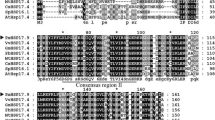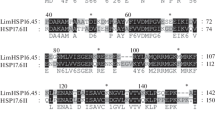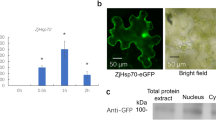Abstract
It is important to reveal the mechanism of plants coping with heat stress, which results in a severe retardation in crop growth and development. Although Synaptotagmin A (SYTA) regulates the cell endocytosis and the plasma membrane reparation of Arabidopsis, its roles in heat resistance are not well understood. In this study, we obtained the new finding that SYTA is related to the heat resistance of Arabidopsis. In the SYTA overexpression strains, the germination rate of the seeds and the survival rate of the seedlings improved after heat shock treatment, and their degree of membrane peroxidation was reduced. However, syta mutant showed the opposite results. Meanwhile, the expressions of some heat stress signal pathway genes were higher in SYTA overexpression strains than that in wild-type strains, and were lower in syta mutant strains. These results suggested that SYTA responded positively to heat shock and was involved in the heat stress signal pathway.






Similar content being viewed by others
References
Aspinall D, Paleg LG (1981) Proline acuumulation: physiological aspects, In: Paleg LG, Aspinall D (eds) The physiology and biochemistry of drought resistance in plant. Academic Press, NewYork, pp 205–211
Baniwal SK, Bharti K, Chan KY, Fauth M, Ganguli A, Kotak S, Mishra SK, Nover L, Port M, Scharf K-D, Tripp J, Weber C, Zielinski D, von Koskull-DÖring P (2004) Heat stress response in plants: a complex game with chaperones and more than twenty heat stress transcription factors. J Biosci 29:471–487
Baniwal SK, Chan KY, Scharf KD, Nover L (2006) Role of heat stress transcription factor HsfA5 as specific repressor of HsfA4. J Biol Chem 282:3605–3613
Basha E, Lee GJ, Breci LA, Hausrath AC, Buan NR, Giese KC, Vierling E (2004a) The identity of proteins associated with a small heat shock protein during heat stress in vivo indicates that these chaperones protect a wide range of cellular functions. J Biol Chem 279:7566–7575
Basha E, Lee GJ, Demeler B, Vierling E (2004b) Chaperone activity of cytosolic small heat shock proteins from wheat. Eur J Biochem 271:1426–1436
Battisti DS, Naylor RL (2009) Historical warnings of future food insecurity with unprecedented seasonal heat. Science 323:240–244
Busch W, Wunderlich M, Schöffl F (2005) Identification of novel heat shock factor-dependent genes and biochemical pathways in Arabidopsis thaliana. Plant J 41(1):1–14
Cao X, Yi J, Wu Z, Luo X, Zhong XH, Wu J, Khan MA, Zhao Y, Yi MF (2013) Involvement of Ca2+ and CaM3 in regulation of thermotolerance in lily (Lilium longiflorum). Plant Mol Biol Rep 31:1293–1304
Chan-Schaminet KY, Baniwal SK, Bublak D, Nover L, Scharf K-D (2009) Specific interaction between tomato HsfA1 and HsfA2 creates hetero-oligomeric superactivator complexes for synergistic activation of heat stress gene expression. J Biol Chem 284(31):20848–20857
Chen SC, Song YJ, Cao JL, Wang G, Wei H, Xu XS, Lu L (2010) Localization and function of calmodulin in livecells of Aspergillus nidulans. Fungal Genet Biol 47(3):268–278
Clough SJ, Bent AF (1998) Floral dip: a simplified method for Agrobacterium- mediated transformation of Arabidopsis thaliana. Plant J 16:735–743
Collins GG, Nie XL, Saltveit ME (1995) Heat shock proteins and chilling sensitivity of mung bean hypocotyls. J Exp Bot 46(7):795–802
Craxton M. Synaptotagmin gene content of the sequenced genomes. BMC Genomics 5(1), 43
Han S, Fang L, Ren XJ, Wang WL, Jiang J (2015) MPK6 controls H2O2-induced root elongation by mediating Ca2+ influx across the plasma membrane of root cells in Arabidopsis seedlings. New Phytol 205(2):695–706
Hiei Y, Ohta S, Komari T, Kumashiro T (1994) Efficient transformation of rice (Oryza sativa L.) mediated by Agrobacterium and sequence analysis of the boundaries of the T-DNA. Plant J 6:271–282
Hodges DM, DeLong JM, Forney CF, Prange RK (1999) Improving the thiobarbituric acid-reactive-substances assay for estimating lipid peroxidation in plant tissues containing anthocyanin and other interfering compounds. Planta 207:604–611
Howarth CJ, Ougham HJ (1993) Gene expression under temperature stress. New Phytol 125(1):1–26
Jörg K, Oliver B, Kenji H (2010) Calcium signals: the lead currency of plant information processing. Plant Cell 22:541–563
Korotaeva NE, Antipina AI, Grabelynch OI, Varakina NN, Borovskii GB, Voinikov VK (2001) Mitochondrial low-molecular -weight heat-shock proteins and the tolerance of cereal mitochondria to hyperthermia. Russ J Plant Physiol 48(6):798–803
Kotak S, Larkindale J, Lee U, von Koskull-Döring P, Vierling E, Scharf K-D (2007) Complexity of the heat stress response in plants. Curr Opin Plant Biol 10:310–316
Lewis JD, Lazarowitz SG (2010) Arabidopsis synaptotagmin SYTA regulates endocytosis and virus movement protein cell-to-cell transport. PNAS 107(6):2491–2496
Li Z, Yue HY, Xing D (2012) MAP Kinase 6-mediated activation of vacuolar processing enzyme modulates heat shock-induced programmed cell death in Arabidopsis. New Phytol 195(1):85–96
Liu HC, Charng YY (2013) Common and distinct functions of Arabidopsis class A1 and A2 heat shock factors in diverse abiotic stress responses and development. Plant Physiol 163(1):276–290
Liu HT, Sun DY, Zhou RG (2005) Ca2+ and AtCaM3 are involved in the expression of heat shock protein gene in Arabidopsis. Plant Cell Environ 28:1276–1284
Liu HC, Liao HT, Charng YY (2011) The role of class A1 heat shock factors (HSFA1s) in response to heat and other stresses in Arabidopsis. Plant Cell Environ 34(5):738–751
Lohmann C, Eggers-Schumacher G, Wunderlich M, Schöffl F (2004) Two different heat shock transcription factors regulate immediate early expression of stress genes in Arabidopsis. Mol Genet Genomics 271:11–21
Madhava RKV, Sresty TVS (2000) Antioxidative parameters in the seedlings of pigeonpea (Cajanus cajan L. Millspaugh) in response to Zn and Ni stresses. Plant Sci 157:113–128
McCord JM (2000) The evolution of free radicals and oxidative stress. Am J Med 108:652–659
Miller G, Mittler R (2006) Could heat shock transcription factors function as hydrogen peroxide sensors in plants. Ann Bot 98:279–288
Mishra SK, Tripp J, Winkelhaus S, Tschiersch B, Theres K, Nover L, Scharf K-D (2002) In the complex family of heat stress transcription factors, HsfA1 has a unique role as master regulator of thermotolerance in tomato. Gene Dev 16:1555–1567
Murashige T, Skoog F (1962) A revised medium for rapid growth and bio assays with tobacco tissue cultures. Physiol Plant 15:473–497
Navari-Izzo F, Rascio N (1999) Plants responses to water deficit conditions. In: Pessarakli M (ed) Handbook of plant and crop stress. Marcel Dekker, New York, pp 231–270
Saidi Y, Finka A, Muriset M, Bromberg Z, Weiss YG, Maathuis FJ, Goloubinoff P (2009) The heat shock response in moss plants is regulated by specific calcium-permeable channels in the plasma membrane. Plant Cell 21:2829–2843
Saidi Y, Finka A, Goloubinoff P (2011) Heat perception and signaling in plants: a tortuous path to thermotolerance. New Phytol 190:556–565
Schapire AL, Voigt B, Jasik J, Rosado A, Lopez-Cobollo R, Menzel D, Salinas J, Mancuso S, Valpuesta V, Baluska F, Botellaa MA (2008) Arabidopsis synaptotagmin 1 is required for the maintenance of plasma membrane integrity and cell viability. Plant Cell 20(12):3374–3388
Schöffl F, Prändl R, Reindl A (1998) Regulation of the heat-shock response. Plant Physiol 117:1135–1141
Simaei M, Khavarinejada RA, Saadatmanda S, Bernardb F, Fahimia H (2011) Interactive effects of salicylic acid and nitric oxide on soybean plants under NaCl salinity. Russ J Plant Physiol 58:783–790
Smirniff N (1993) The role of active oxygen in the responses of plants to water deficit and desiccation. New Phytol 125:27–58
Snider JL, Oosterhuis D, Kawakami E (2011) Mechanisms of reproductive thermotolerance in Gossypium hirsutum: the effect of genotype and exogenous calcium application. J Agron Crop Sci 19:228–236
Sung DY, Guy CL (2003) Physiological and molecular assessment of altered expression of Hsc70-1 in Arabidopsis. Evidence for pleiotropic consequences. Plant Physiol 132:979–987
Sung D, Vierling E, Guy CL (2001) Comprehensive expression profile analysis of the Arabidopsis Hsp70 gene family. Plant Physiol 126:789–800
von Koskull-Döring P, Scharf KD, Nover L (2007) The diversity of plant heat stress transcription factors. Trends Plant Sci 12(10):452–457
Wahid A, Gelani S, Ashraf M, Foolad MR (2007) Heat tolerance in plants: an overview. Environ Exp Bot 61:199–223
Wunderlich M, Werr W, Schoffl F (2003) Generation of dominant-negative effects on the heat shock response in Arabidopsis thaliana by transgenic expression of a chimaeric HSF1 protein fusion construct. Plant J 35:442–451
Xuan Y, Zhou S, Wang L, Cheng YD, Zhao LQ (2010) Nitric oxide functions as a signal and acts upstream of AtCaM3 in thermotolerance in Arabidopsis seedlings. Plant Physiol 153:1895–1906
Yamazaki T, Kawamura Y, Minami A, Uemura M (2008) Calcium-dependent freezing tolerance in Arabidopsis involves membrane resealing via synaptotagmin SYT1. Plant Cell 20(12):3389–3404
Yamazaki T, Takata N, Uemura M, Kawamura Y (2010) Arabidopsis synaptotagmin SYT1, a type I signal-anchor protein, requires tandem C2 domains for delivery to the plasma membrane. J Bio Chem 285(30):23165–23176
Yoshida T, Ohama N, Nakajima J, Kidokoro S, Mizoi J, Nakashima K, Maruyama K, Kim J-M, Seki M, Todaka D, Osakabe Y, Sakuma Y, Schöz F, Shinozaki K, Yamaguchi-Shinozaki K (2011) Arabidopsis HsfA1 transcription factors function as the main positive regulators in heat shock-responsive gene expression. Mol Genet Genomics 286(5–6):321–332
Zhang HX, Hodson JN, Williams JP, Blumwald E (2001) Engineering salt-tolerant Brassica plants: characterization of yield and seed oil quality in transgenic plants with increased vacuolar sodium accumulation. Proc Natl Acad Sci USA 98:12832–12836
Zhang L, Lohmann C, Prandl R, Schöffl F (2003) Heat stress-dependent DNA binding of Arabidopsis heat shock transcription factor HSF1 to heat shock gene promoters in Arabidopsis suspension culture cells in vivo. J Biol Chem 384:959–963
Zhang W, Zhou RG, Gao YJ, Zheng SZ, Xu P, Zhang SQ, Sun DY (2009) Molecular and genetic evidence for the key role of AtCaM3 in heat-shock signal transduction in Arabidopsis. Plant Physiol 149:1773–1784
Zheng SZ, Liu YL, Li B, Shang ZL, Zhou RG, Sun DY (2012) Phosphoinositide-specific phospholipase C9 is involved in the thermotolerance of Arabidopsis. Plant J 69:689–700
Acknowledgments
We thank Dr. Dekuan Li, Qin Luo, and postgraduate Linfeng Xie for providing syta mutant seeds. The work presented here was supported by the National Natural Science Foundation of China (Grant Nos. 30971557, 31300996).
Author information
Authors and Affiliations
Corresponding author
Ethics declarations
Conflict of interest
The authors declare that they have no competing interests.
Electronic supplementary material
Below is the link to the electronic supplementary material.
Rights and permissions
About this article
Cite this article
Yan, Q., Huang, Q., Chen, J. et al. SYTA has positive effects on the heat resistance of Arabidopsis . Plant Growth Regul 81, 467–476 (2017). https://doi.org/10.1007/s10725-016-0224-5
Received:
Accepted:
Published:
Issue Date:
DOI: https://doi.org/10.1007/s10725-016-0224-5




